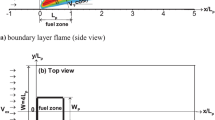Abstract
Different propulsion systems can be used for launching payloads into orbit and for attitude control, orbit correction and maneuvering of satellites. Liquid bipropellant thrusters are used in applications requiring high specific impulses and high thrust levels and numerical simulation models can reduce development costs and time. This work describes a new 2D numerical model based on the boundary layer equations for the simulation of spray combustion. This model can be applied to the preliminary design of rocket combustion chambers, and allows the determination of droplet vaporization lengths, chemical composition, temperature profile and other thermodynamic and propulsion parameters. The computation time is, in general, lower than more complex 2D and 3D simulation models. Liquid fuel and oxidizer are injected into the combustion chamber with known droplet sizes and a pre-existing gas flow, which represents combustion products recirculation. The governing equations are discretized using centered and backward finite differences and the solution is marched downstream, considering droplet evaporation, mixture and combustion of propellant vapors with pre-existing gases. Burning of unsymmetrical dimethylhydrazine (UDMH) and dinitrogen tetroxide (NTO) was simulated with different mixture conditions and taking into account eleven product species. The model was validated by considering separately the different routines, comparing results of internal boundary layer flows, droplet evaporation and combustion products composition against expected theoretical behavior and results from other models. The influence of the equivalence ratio radial distribution on flow parameters was evaluated. The gas temperatures near the wall remained relatively constant after a certain distance downstream, depending on the local equivalence ratio distribution. The boundary layer remained very thin along the chamber due to the constant addition of combustion products.



















Similar content being viewed by others
References
Cheng GC, Farmer R (2006) Real fluid modeling of multiphase flows in liquid rocket engine combustors. J Propul Power 22(6):1373–1381
Chin JS, Lefebvre AH (1983) Steady-state evaporation characteristics of hydrocarbon fuel drops. AIAA J 21(10):1437–1443
Haidn OJ (2001) 2nd international workshop on rocket combustion modeling. DLR and European Office of Aerospace Research and Development, DLR, Langer Grund Lampoldshausen, Germany
Kalmykov GP, Larionov AA, Sidlerov DA, Yanchilin LA (2009) Numerical simulation of operation processes in the combustion chamber and gas generator of oxygen-methane liquid rocket engine. Prog Propul Phys 1:185–204
Kang YD, Sun B (2011) Numerical simulation of liquid rocket engine thrust chamber regenerative cooling. J Thermophys Heat Transf 25(1):155–164
Kuo KK (1986) Principles of combustion. Wiley-Interscience. Wiley, New York
Law CK (2006) Combustion physics. Cambridge University Press, Cambridge
Lefebvre AH, McDonell VG (2017) Atomization and sprays, 2nd edn. CRC Press, Boca Raton
Maya E, Valdes J (2018) Numerical modeling of combustion process in hybrid rocket engines using open source software. American Institute of Aeronautics and Astronautics, AIAA, Ohio, USA, AIAA paper 2018-4438
Mazzeti A, Barbante P (2016) Numerical modeling of combustion processes in hybrid rocket engines. Int J Energetic Mater Chem Propul 15(3):249–2746. https://doi.org/10.1615/IntJEnergeticMaterialsChemProp.2016013641
McBride BJ, Gordon S, Reno MA (1993) Coefficients for calculating thermodynamic and transport properties of individual species. Reference publication 4513, National Aeronautics and Space Administration, National Aeronautics and Space Administration. Lewis Research Center. Cleveland, Ohio 44135
Oefelein JC, Yang V (1998) Modeling high-pressure mixing and combustion processes in liquid rocket engines. J Propul Power 14(5):843–857
Poling BE, Prausnitz JH, O’Connell JP (1977) The properties of gases and liquids, 5th edn. McGraw-Hill, New York
Raman V, Hassanaly M (2019) Emerging trends in numerical simulations of combustion systems. Proc Combust Inst 37(2):2073–2089
Riedmann H, Banuti D, Ivancic B, Knab O, Hannemann K (2019) Modeling of h2/o2 single-element rocket thrust chamber combustion at sub- and supercritical pressures with different computational fluid dynamics tools. Prog Propul Phys 11:247–272
Salvador CAV, Costa FS (2006) Vaporization lengths of hydrazine fuels burning wih nto. J Propul Power 22(6):1362–1372
Salvador NM, Mendonca MT, Dourado WMC (2013) Large eddy simulation of bluff body stabilized turbulent premixed flame. J Aerosp Technol Manag 5(2):181–196
Svehla RA (1995) Transport coefficients for the Nasa Lewis chemical equilibrium program. Technical Memorandum 4647, NASA, National Aeronautics and Space Administration. Lewis Research Center. Cleveland, Ohio 44135
Xu J, Jin P, Li R, Wang J, Cai G (2020) Effect of coaxial injector parameters on lox/methane engines: a numerical analysis. Acta Astronaut 171:225–237
Acknowledgements
The author acknowledges the financial support from CAPES (Coordenadoria de Aperfeiçoamento de Pessoal de Nível Superior) and CNPq (Conselho Nacional de Desenvolvimento Científico e Tecnológico). Both financial supports are grants from Government institutions related to higher education and public research funding. The authors have no Conflict of interest to declare that are relevant to the content of this article. The authors are solely responsible for the printed material included in this paper.
Author information
Authors and Affiliations
Corresponding author
Additional information
Technical Editor: Mario Eduardo Santos Martins.
Publisher's Note
Springer Nature remains neutral with regard to jurisdictional claims in published maps and institutional affiliations.
Rights and permissions
Springer Nature or its licensor (e.g. a society or other partner) holds exclusive rights to this article under a publishing agreement with the author(s) or other rightsholder(s); author self-archiving of the accepted manuscript version of this article is solely governed by the terms of such publishing agreement and applicable law.
About this article
Cite this article
Costa, E.M.S., Mendonca, M.T., Costa, F.S. et al. A two-dimensional boundary layer model for combustion chamber simulation. J Braz. Soc. Mech. Sci. Eng. 46, 280 (2024). https://doi.org/10.1007/s40430-024-04843-9
Received:
Accepted:
Published:
DOI: https://doi.org/10.1007/s40430-024-04843-9




